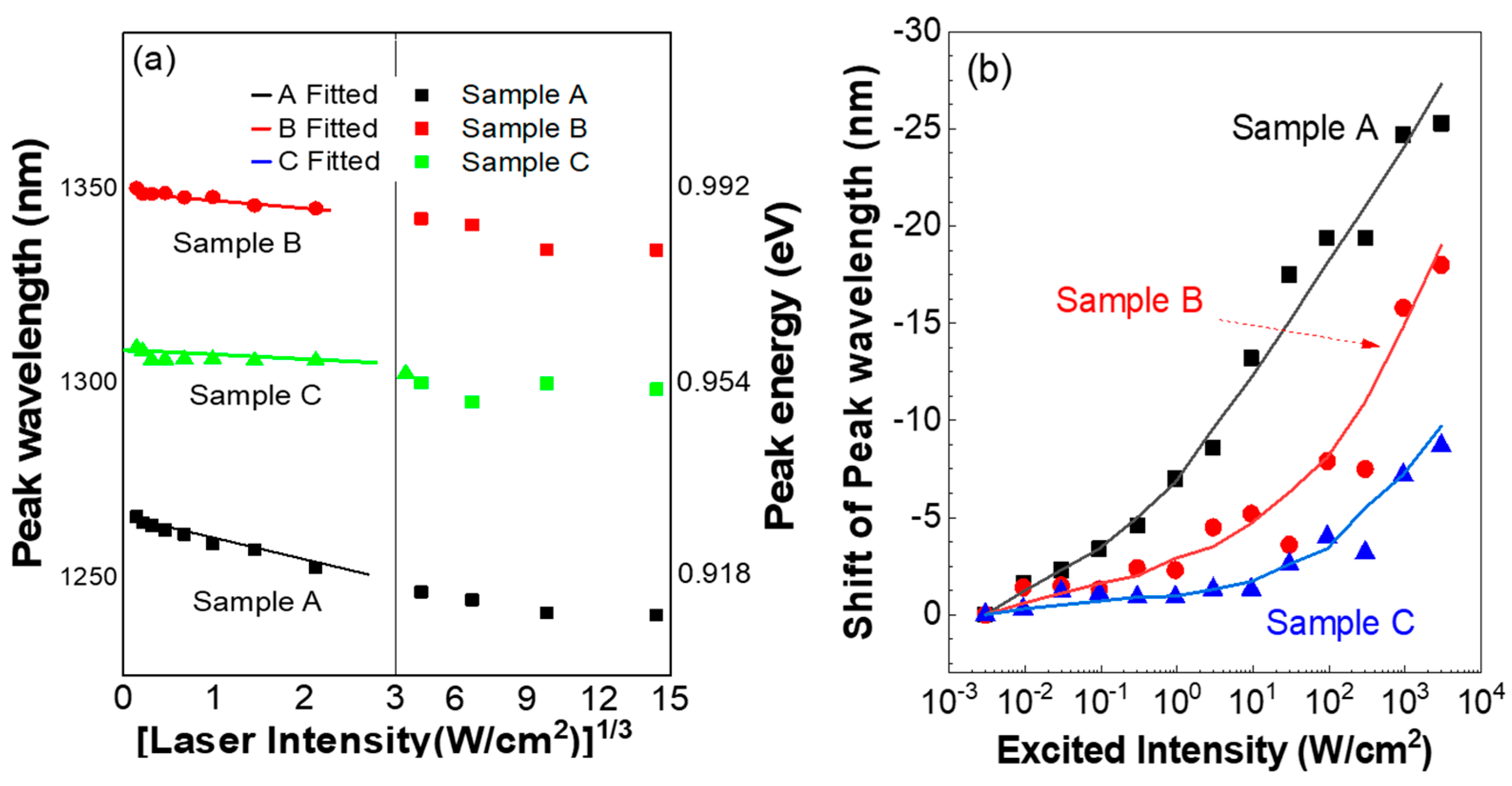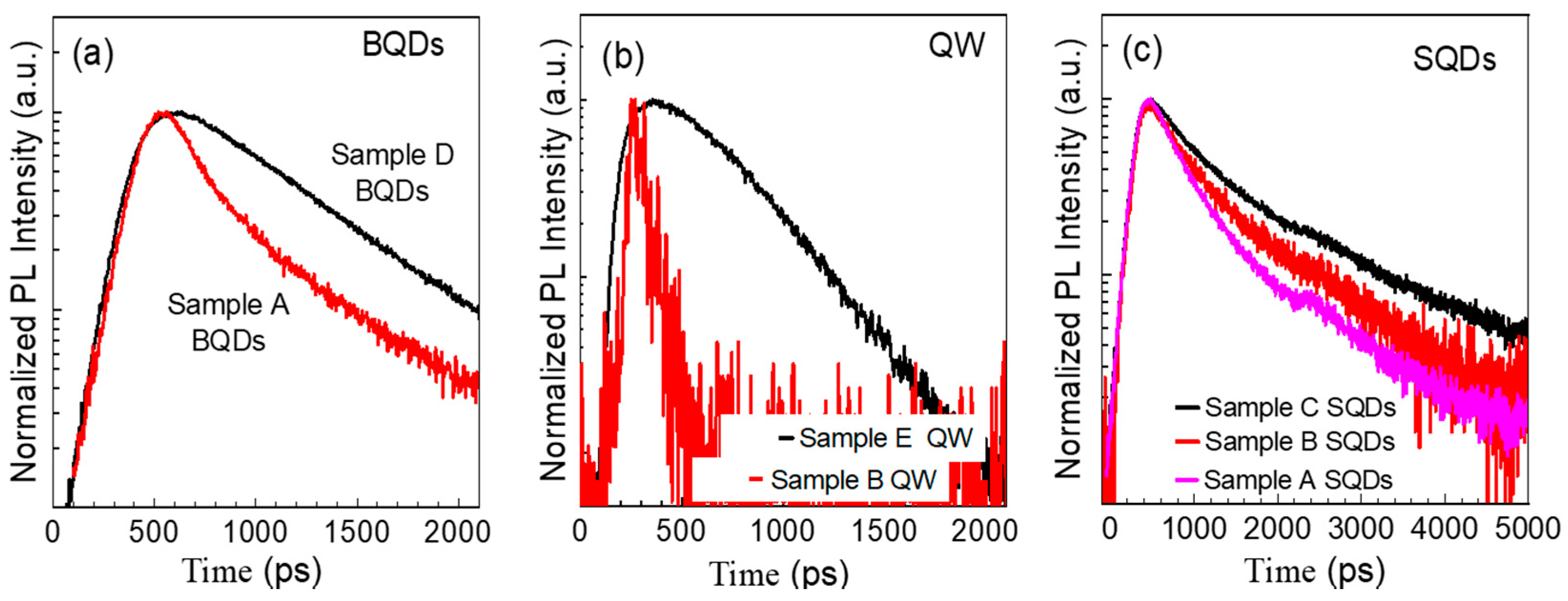Carrier Injection to In0.4Ga0.6As/GaAs Surface Quantum Dots in Coupled Hybrid Nanostructures
Abstract
1. Introduction
2. Materials and Methods
3. Results
4. Conclusions
Author Contributions
Funding
Institutional Review Board Statement
Informed Consent Statement
Data Availability Statement
Conflicts of Interest
References
- Leonard, D.; Krishnamurthy, M.; Reaves, C.M.; Denbaars, S.P.; Petroff, P.M. Direct formation of quantum-sized dots from uniform coherent islands of InGaAs on GaAs surfaces. Appl. Phys. Lett. 1993, 63, 3203–3205. [Google Scholar] [CrossRef]
- Bhattacharya, P.; Ghosh, S.; Stiff-Roberts, A.D. Quantum dot opto-electronic devices. Annu. Rev. Mater. Sci. 2004, 34, 1–40. [Google Scholar] [CrossRef]
- Chuang, K.Y.; Tzeng, T.E.; Lay, T.S. Coupled InGaAs Quantum Dots for Electro-Optic Modulation. Crystals 2021, 11, 1159. [Google Scholar] [CrossRef]
- Shang, X.J.; Li, S.L.; Liu, H.Q.; Ma, B.; Su, X.B.; Chen, Y.; Shen, J.X.; Hao, H.M.; Liu, B.; Dou, X.M.; et al. Symmetric Excitons in an (001)-Based InAs/GaAs Quantum Dot Near Si Dopant for Photon-Pair Entanglement. Crystals 2021, 11, 1194. [Google Scholar] [CrossRef]
- Ferdos, F.; Wang, S.M.; Wei, Y.Q.; Larsson, A.; Sadeghi, M.; Zhao, Q.X. Influence of a thin GaAs cap layer on structural and optical properties of InAs quantum dots. Appl. Phys. Lett. 2002, 81, 1195–1197. [Google Scholar] [CrossRef]
- Jin, P.; Meng, X.Q.; Zhang, Z.Y.; Li, C.M.; Xu, B.; Liu, F.Q.; Wang, Z.G.; Li, Y.G.; Zhang, C.Z.; Pan, S.H. Effect of InAs quantum dots on the Fermi level pinning of undoped-n+ type GaAs surface studied by contactless electroreflectance. J. Appl. Phys. 2003, 93, 4169–4172. [Google Scholar] [CrossRef]
- Duijs, E.F.; Findeis, F.; Deutschmann, R.A.; Bichler, M.; Zrenner, A.; Abstreiter, G.; Adlkofer, K.; Tanaka, M.; Sackmann, E. Influence of Thiol Coupling on Photoluminescence of Near Surface InAs Quantum Dots. Phys. Status Solidi B 2001, 224, 871–875. [Google Scholar] [CrossRef]
- Jin, P.; Meng, X.Q.; Zhang, Z.Y.; Li, C.M.; Qu, S.C.; Xu, B.; Liu, F.Q.; Wang, Z.G.; Li, Y.G.; Zhang, C.Z.; et al. Modulation Spectroscopy of GaAs Covered by InAs Quantum Dots. Chin. Phys. Lett. 2002, 19, 1010–1012. [Google Scholar]
- Chen, M.X.; Kobashi, K. Probing into hybrid organic-molecule and InAs quantum-dots nanosystem with multistacked dots-in-a-well units. J. Appl. Phys. 2012, 112, 064903. [Google Scholar] [CrossRef]
- Milla, M.J.; Ulloa, J.M.; Guzmán, Á. Strong Influence of the Humidity on the Electrical Properties of InGaAs Surface Quantum Dots. ACS Appl. Mater. Interfaces 2014, 6, 6191–6195. [Google Scholar] [CrossRef]
- Trevisi, G.; Seravalli, L.; Frigeri, P. Photoluminescence monitoring of oxide formation and surface state passivation on InAs quantum dots exposed to water vapor. Nano Res. 2016, 9, 3018–3026. [Google Scholar] [CrossRef]
- Yuan, Q.; Liu, J.T.; Liang, B.L.; Ren, D.K.; Wang, Y.; Guo, Y.N.; Wang, S.F.; Fu, G.S.; Mazur, Y.I.; Ware, M.E.; et al. Lateral carrier transfer for high density InGaAs/GaAs surface quantum dots. J. Lumin. 2020, 218, 116870. [Google Scholar] [CrossRef]
- Milla, M.J.; Ulloa, J.M.; Guzman, A. Photoexcited induced sensitivity of InGaAs surface QDs to environment. Nanotechnology 2014, 25, 445501. [Google Scholar] [CrossRef] [PubMed][Green Version]
- Yuan, Q.; Liang, B.L.; Zhou, C.; Wang, Y.; Guo, Y.N.; Wang, S.F.; Fu, G.S.; Mazur, Y.I.; Ware, M.E.; Salamo, G.J. Interplay effect of temperature and excitation intensity on the photoluminescence of InGaAs/GaAs surface quantum dots. Nanoscale Res. Lett. 2018, 13, 387. [Google Scholar] [CrossRef] [PubMed]
- Wang, G.D.; Liang, B.L.; Juang, B.C.; Das, A.; Debnath, M.C.; Huffaker, D.L.; Mazur, Y.I.; Ware, M.E.; Salamo, G.J. Comparative study of photoluminescence from In0.3Ga0.7As/GaAs surface and buried quantum dots. Nanotechnology 2016, 27, 465701. [Google Scholar] [CrossRef]
- Wang, G.D.; Ji, H.Q.; Shen, J.L.; Xu, Y.H.; Liu, X.L.; Fu, Z.Y. Strong Influence of Temperature and Vacuum on the Photoluminescence of In0.3Ga0.7As Buried and Surface Quantum Dots. Photonic Sens. 2018, 8, 213–219. [Google Scholar] [CrossRef]
- Wang, G.D.; Liu, Z.G.; Wang, J.J.; Yang, Y.L.; Liu, X.L.; Zhang, X.R.; Zhang, L.W.; Cao, G.H. Gas Sensitivity of In0.3Ga0.7 As Surface QDs Coupled to Multilayer Buried QDs. Photonic Sens. 2020, 10, 283–290. [Google Scholar] [CrossRef]
- Liang, B.L.; Wang, Z.M.; Mazur, Y.I.; Salamo, G.J. Photoluminescence of surface InAs quantum dot stacking on multilayer buried quantum dots. Appl. Phys. Lett. 2006, 89, 243124. [Google Scholar] [CrossRef]
- Liu, J.T.; Yuan, Q.; Liang, B.L.; Yan, Q.G.; Wang, Y.; Wang, C.S.; Wang, S.F.; Fu, G.S.; Mazur, Y.I.; Ware, M.E.; et al. Photoluminescence characterization of wetting layer and carrier dynamics for coupled InGaAs/GaAs surface quantum dot pair structures. Opt. Express 2020, 28, 20704–20713. [Google Scholar] [CrossRef]
- Walter, G.; Chung, T.; Holonyak, N., Jr. High-gain coupled InGaAs quantum well InAs quantum dot AlGaAs–GaAs–InGaAs–InAs heterostructure diode laser operation. Appl. Phys. Lett. 2002, 80, 1126–1128. [Google Scholar] [CrossRef]
- Rudno-Rudziński, W.; Sęk, G.; Ryczko, K.; Syperek, M.; Misiewicz, J.; Semenova, E.S.; Lemaitre, A.; Ramdane, A. Room temperature free carrier tunneling in dilute nitride based quantum well -quantum dot tunnel injection system for 1.3 m. Appl. Phys. Lett. 2009, 94, 171906. [Google Scholar] [CrossRef]
- Walter, G.; Holonyak, N., Jr.; Ryou, J.H.; Dupuis, R.D. Coupled InP quantum-dot InGaP quantum well InP–InGaP–In(AlGa)P–InAlP heterostructure diode laser operation. Appl. Phys. Lett. 2001, 79, 3215–3217. [Google Scholar] [CrossRef]
- Amtout, A.; Raghavan, S.; Rotella, P.; Von Winckel, G.; Stintz, A.; Krishna, S. Theoretical modeling and experimental characterization of InAs/InGaAs quantum dots in a well detector. J. Appl. Phys. 2004, 96, 3782–3784. [Google Scholar] [CrossRef]
- Persano, A.; Cola, A.; Taurino, A.; Catalano, M.; Lomascolo, M.; Convertino, A.; Leo, G.; Cerri, L.; Vasanelli, A.; Vasanelli, L. Electronic structure of double stacked InAs/GaAs quantum dots: Experiment and theory. J. Appl. Phys. 2007, 101, 094314. [Google Scholar] [CrossRef]
- Talalaev, V.G.; Tomm, J.W.; Zakharov, N.D.; Werner, P.; Novikov, B.V.; Tonkikh, A.A. Transient spectroscopy of InAs quantum dot molecules. Appl. Phys. Lett. 2004, 85, 284–286. [Google Scholar] [CrossRef]
- Howe, P.; Abbey, B.; Le Ru, E.C.; Murray, R.; Jones, T.S. Strain-interactions between InAs/GaAs quantum dot layers. Thin Solid Film. 2004, 464–465, 225–228. [Google Scholar] [CrossRef]
- Xie, Q.; Madhukar, A.; Chen, P.; Kobayashi, N.P. Vertically self-organized InAs quantum box islands on GaAs (100). Phys. Rev. Lett. 1995, 75, 2542–2545. [Google Scholar] [CrossRef]
- Alonso-Álvarez, D.; Alén, B.; Ripalda, J.M.; Rivera, A.; Taboada, A.G.; Llorens, J.M.; González, Y.; González, L.; Briones, F. Strain driven migration of In during the growth of InAs/GaAs quantum posts. APL Mater. 2013, 1, 022112. [Google Scholar] [CrossRef]
- Liu, X.H.; Liu, J.T.; Liang, B.L.; Wang, Y.; Wang, S.F.; Fu, G.S.; Mazur, Y.I.; Maidaniuk, Y.; Ware, M.E.; Salamo, G.J. Type-II characteristics of photoluminescence from InGaAs/GaAs surface quantum dots due to Fermi level pinning effect. Appl. Surf. Sci. 2022, 578, 152066. [Google Scholar] [CrossRef]
- Mazur, Y.I.; Dorogan, V.G.; Guzun, D.; Marega, E., Jr.; Salamo, G.J.; Tarasov, G.G.; Govorov, A.O.; Vasa, P.; Lienau, C. Measurement of coherent tunneling between InGaAs quantum wells and InAs quantum dots using photoluminescence spectroscopy. Phys. Rev. B 2010, 82, 155413. [Google Scholar] [CrossRef]
- Mazur, Y.I.; Dorogan, V.G.; Marega, E., Jr.; Benamara, M.; Zhuchenko, Z.Y.; Tarasov, G.G.; Lienau, C.; Salamo, G.J. Excited state coherent resonant electronic tunneling in quantum well-quantum dot hybrid structures. Appl. Phys. Lett. 2011, 98, 083118. [Google Scholar] [CrossRef]
- Syperek, M.; Andrzejewski, J.; Rudno-Rudzinski, W.; Sek, G.; Misiewicz, J.; Pavelescu, E.M.; Gilfert, C.; Reithmaier, J.P. Influence of electronic coupling on the radiative lifetime in the (In,Ga)As/GaAs quantum dot–quantum well system. Phys. Rev. B 2012, 85, 125311. [Google Scholar] [CrossRef]
- Sek, G.; Andrzejewski, J.; Ryczko, K.; Poloczek, P.; Misiewicz, J.; Semenova, E.S.; Lemaitre, A.; Patriarche, G.; Ramdane, A. Electronic structure properties of the In(Ga)As/GaAs quantum dot–quantum well tunnel-injection system. Semicond. Sci. Technol. 2009, 24, 085011. [Google Scholar]
- Klenovský, P.; Steindl, P.; Geffroy, D. Excitonic structure and pumping power dependent emission blueshift of type-II quantum dots. Sci. Rep. 2017, 7, 45568. [Google Scholar] [CrossRef] [PubMed]
- Jin, S.R.; Zheng, Y.L.; Li, A.Z. Characterization of photoluminescence intensity and efficiency of free excitons in semiconductor quantum well structures. J. Appl. Phys. 1997, 82, 3870–3873. [Google Scholar] [CrossRef]
- Wang, Y.; Sheng, X.Z.; Yuan, Q.; Guo, Q.L.; Wang, S.F.; Fu, G.S.; Liang, B.L.; Huffaker, D.L.; Mazur, Y.I.; Yurii, M.; et al. Carrier dynamics in hybrid nanostructure with electronic coupling from an InGaAs quantum well to InAs quantum dots. J. Lumin. 2018, 202, 20–26. [Google Scholar] [CrossRef]
- Zhang, X.B.; Ryou, J.H.; Dupuis, R.D.; Walter, G.; Holonyak, N., Jr. Temperature-dependent luminescence of InP quantum dots coupled with an InGaP quantum well and of InP quantum dots in a quantum well. Appl. Phys. Lett. 2005, 87, 201110. [Google Scholar] [CrossRef]
- Goodfellow, K.M.; Chakraborty, C.; Sowers, K.; Waduge, P.; Wanunu, M.; Krauss, T.; Driscoll, K.; Vamivakas, A.N. Distance-dependent energy transfer between CdSe/CdS quantum dots and a two dimensional semiconductor. Appl. Phys. Lett. 2016, 108, 021101. [Google Scholar] [CrossRef]
- Liu, Y.; Liang, B.L.; Guo, Q.L.; Wang, S.F.; Fu, G.S.; Fu, N.; Mazur, Y.I.; Ware, M.E.; Salamo, G.J. Electronic coupling in nanoscale InAs/GaAs quantum dot pairs separated by a thin Ga(Al)As spacer. Nanoscale Res. Lett. 2015, 10, 271. [Google Scholar] [CrossRef]
- Alonso-Álvarez, D.; Alén, B.; García, J.M.; Ripalda, J.M. Optical investigation of type II GaSb/GaAs self-assembled quantum dots. Appl. Phys. Lett. 2007, 91, 263103. [Google Scholar] [CrossRef]
- Chiu, Y.S.; Ya, M.H.; Su, W.S.; Chen, Y.F. Properties of photoluminescence in type-II GaAsSb/GaAs multiple quantum wells. J. Appl. Phys. 2002, 92, 5810–5813. [Google Scholar] [CrossRef]
- Couto, O.D.D., Jr.; de Almeida, P.T.; dos Santos, G.E.; Balanta, M.A.G.; Andriolo, H.F.; Brum, J.A.; Brasil, M.J.S.P.; Iikawa, F.; Liang, B.L.; Huffaker, D.L. Carrier dynamics dictated by bimolecular recombination in type-II quantum dots coupled to quantum wells. J. Appl. Phys. 2016, 120, 084305. [Google Scholar] [CrossRef]
- Liu, Y.; Wang, Y.; Liang, B.L.; Guo, Q.L.; Wang, S.F.; Fu, G.S.; Mazur, Y.I.; Ware, M.E.; Salamo, G.J. Interplay effect of excitation and temperature on carrier transfer between vertically aligned InAs/GaAs quantum dot pairs. Crystals 2016, 6, 144. [Google Scholar] [CrossRef]






Publisher’s Note: MDPI stays neutral with regard to jurisdictional claims in published maps and institutional affiliations. |
© 2022 by the authors. Licensee MDPI, Basel, Switzerland. This article is an open access article distributed under the terms and conditions of the Creative Commons Attribution (CC BY) license (https://creativecommons.org/licenses/by/4.0/).
Share and Cite
Liu, J.; Luo, S.; Liu, X.; Wang, Y.; Wang, C.; Wang, S.; Fu, G.; Mazur, Y.I.; Ware, M.E.; Salamo, G.J.; et al. Carrier Injection to In0.4Ga0.6As/GaAs Surface Quantum Dots in Coupled Hybrid Nanostructures. Crystals 2022, 12, 319. https://doi.org/10.3390/cryst12030319
Liu J, Luo S, Liu X, Wang Y, Wang C, Wang S, Fu G, Mazur YI, Ware ME, Salamo GJ, et al. Carrier Injection to In0.4Ga0.6As/GaAs Surface Quantum Dots in Coupled Hybrid Nanostructures. Crystals. 2022; 12(3):319. https://doi.org/10.3390/cryst12030319
Chicago/Turabian StyleLiu, Jingtao, Shiping Luo, Xiaohui Liu, Ying Wang, Chunsheng Wang, Shufang Wang, Guangsheng Fu, Yuriy I. Mazur, Morgan E. Ware, Gregory J. Salamo, and et al. 2022. "Carrier Injection to In0.4Ga0.6As/GaAs Surface Quantum Dots in Coupled Hybrid Nanostructures" Crystals 12, no. 3: 319. https://doi.org/10.3390/cryst12030319
APA StyleLiu, J., Luo, S., Liu, X., Wang, Y., Wang, C., Wang, S., Fu, G., Mazur, Y. I., Ware, M. E., Salamo, G. J., & Liang, B. (2022). Carrier Injection to In0.4Ga0.6As/GaAs Surface Quantum Dots in Coupled Hybrid Nanostructures. Crystals, 12(3), 319. https://doi.org/10.3390/cryst12030319





